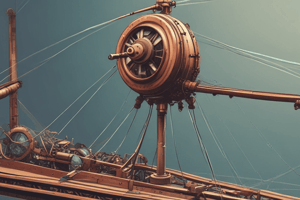Podcast
Questions and Answers
¿Cuál es el propósito principal de una máquina simple?
¿Cuál es el propósito principal de una máquina simple?
- Cambiar la dirección o magnitud de una fuerza (correct)
- Cambiar la velocidad de un objeto
- Aumentar la masa de un objeto
- Reducir la fricción entre dos superficies
¿Cuál es el nombre del punto fijo autour del cual pivota un brazo de palanca?
¿Cuál es el nombre del punto fijo autour del cual pivota un brazo de palanca?
- Punto de giro
- Fulcro (correct)
- Eje
- Punto de apoyo
¿Cuál es la máquina simple que se utiliza para cambiar la dirección de una fuerza o levantar cargas pesadas?
¿Cuál es la máquina simple que se utiliza para cambiar la dirección de una fuerza o levantar cargas pesadas?
- Wheel and axle
- Wedge
- Pulley (correct)
- Inclined plane
¿Cuál es el nombre del dispositivo que se utiliza para reducir la fricción y hacer que el movimiento sea más fácil?
¿Cuál es el nombre del dispositivo que se utiliza para reducir la fricción y hacer que el movimiento sea más fácil?
¿Cuál es la relación entre la fuerza de salida y la fuerza de entrada en una máquina simple?
¿Cuál es la relación entre la fuerza de salida y la fuerza de entrada en una máquina simple?
¿Qué es un ejemplo de una máquina simple que se utiliza para separar objetos?
¿Qué es un ejemplo de una máquina simple que se utiliza para separar objetos?
¿Cuál es la máquina simple que se utiliza para levantar objetos a una posición más alta?
¿Cuál es la máquina simple que se utiliza para levantar objetos a una posición más alta?
¿Cuál es el nombre del eje fijo autour del cual rota una rueda?
¿Cuál es el nombre del eje fijo autour del cual rota una rueda?
¿Cuál es la máquina simple que se utiliza para levantar o mover objetos?
¿Cuál es la máquina simple que se utiliza para levantar o mover objetos?
Study Notes
Simple Machines
Definition
- A simple machine is a device that changes the direction or magnitude of a force, making it easier to lift, move, or manipulate objects.
- There are six types of simple machines: lever, pulley, wheel and axle, inclined plane, wedge, and screw.
Types of Simple Machines
1. Lever
- A rigid bar or beam that pivots around a fixed point (fulcrum).
- Used to change the direction or magnitude of a force.
- Examples: seesaw, crowbar, scissors.
2. Pulley
- A wheel with a grooved rim and a rope or cable wrapped around it.
- Used to change the direction of a force or lift heavy loads.
- Examples: elevator, crane, window blinds.
3. Wheel and Axle
- A circular object (wheel) attached to a fixed axis (axle).
- Used to reduce friction and make movement easier.
- Examples: bicycle, car, Ferris wheel.
4. Inclined Plane
- A flat surface tilted at an angle.
- Used to lift or move heavy objects to a higher position.
- Examples: ramp, staircase, escalator.
5. Wedge
- A triangular-shaped object with a sloping edge.
- Used to split, separate, or hold objects together.
- Examples: knife, axe, doorstop.
6. Screw
- A cylindrical object with a spiral ridge (thread).
- Used to lift, hold, or move objects.
- Examples: screwdriver, jar lid, drill bit.
Key Concepts
- Mechanical advantage: the ratio of output force to input force.
- Fulcrum: the fixed point around which a lever pivots.
- Axis: the fixed point around which a wheel and axle rotate.
Studying That Suits You
Use AI to generate personalized quizzes and flashcards to suit your learning preferences.
Description
Learn about the six types of simple machines, including levers, pulleys, wheel and axle, inclined planes, wedges, and screws. Understand their definitions, examples, and key concepts like mechanical advantage and fulcrum.




